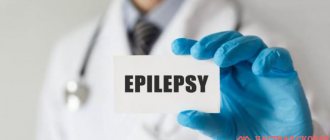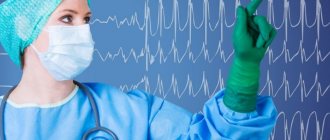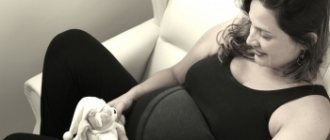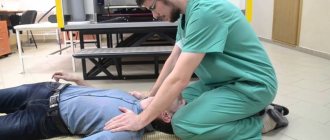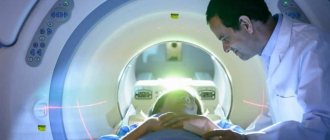Surely many, upon hearing the word “epilepsy,” will say that this is a mental illness and should be treated by a psychiatrist. This is fundamentally wrong. If you suspect epilepsy, you need to see a neurologist, since epileptology, the science that studies epilepsy, is a branch of neurology.
A child with epilepsy can be observed by a psychiatrist if he has mental disorders caused by epilepsy itself or concomitant pathologies. But epilepsy itself is treated by a neurologist.
What examination helps identify epilepsy?
Epilepsy is a chronic disease in which foci of excessive excitation appear in the brain. It can occur at any age. According to the World Health Organization, about 50,000,000 people worldwide suffer from epilepsy. The proportion of the population with active epilepsy (and therefore in need of treatment) in 2021 ranges from 4 to 10 per 1000 people.
The only method for reliably detecting epilepsy is an EEG - a recording of the electrical activity of the brain, which makes it possible to detect these foci.
Additional methods - MRI, computed tomography, genetic studies help to carry out differential diagnosis, for example, to identify the site of hemorrhage or tumor, the presence of hereditary pathology.
A typical EEG session lasts 20-30 minutes and quite often does not reveal any signs of disease in a child or adult, even if there were suspicious symptoms.
Therefore, if there is a suspicion of epilepsy, video EEG monitoring of sleep and a long period of wakefulness is carried out with functional tests (synonyms are video EEG monitoring of night sleep, video EEG monitoring of daytime sleep, video EEG monitoring of night sleep, video EEG monitoring of 24 hours, and so on), which allow you to provoke an attack. Parents are often worried when they hear that the doctor will try to cause an attack, however, sometimes this is the only way to make a completely reliable diagnosis.
Parents should be aware that most children whose EEG shows epileptiform activity do not have epilepsy . They are at risk, but often do not suffer a single attack in their entire lives and do not need any treatment. Moreover, 10% of people have experienced a convulsive episode at least once in their lives, but they are not diagnosed with epilepsy, since one of the main criteria for making such a diagnosis is the regularity of attacks.
Manifestations of epilepsy are not:
- Sleepwalking (sleepwalking). Sleepwalking in itself is not a manifestation of epilepsy. If any other symptoms are present, they must be considered together.
- Headache. Headache is a syndrome that can indicate the presence of a variety of diseases and must also be considered in conjunction with other symptoms.
- Hyperkinesis, tics. Hyperkinesis is a violent stereotypical movement; in children it can be a manifestation of a whole group of diseases and is not always an indication for an EEG.
- Bedwetting (enuresis). It occurs both in children with epilepsy and in those who do not suffer from it.
Causes of epilepsy
Epilepsy has more than 50 forms of manifestation of the disease, so it is extremely important to establish an accurate diagnosis and cause of the disease. This will facilitate the correct choice of treatment method. With the help of electroencephalography, it becomes possible to determine the indicators characteristic of each form, since the pathology is expressed by the discharge of brain neurons.
The main causes of epilepsy include:
- oxygen starvation during difficult childbirth;
- infections suffered by a woman during pregnancy, such as cytomegalovirus, rubella, herpes, toxoplasmosis and others;
- traumatic brain injuries;
- alcoholism or drug addiction;
- brain tumors;
- strokes;
- hereditary factor.
Based on the causes of epilepsy, the disease is divided into three groups:
- idiopathic – the presence of a genetic predisposition;
- symptomatic – there are structural defects in the brain;
- cryptogenic – the causes of the disease cannot be determined.
At the Yusupov Hospital, genetic studies are carried out to determine the hereditary factor. This helps determine the possibility of a hereditary factor in the development of the disease. Also during the examination, other tests are prescribed to determine the concentration of substances in the drugs in the body. These actions are carried out to adjust the dose of medications.
What should parents pay attention to?
The first and most important thing is to remember that epilepsy is not always seizures with loss of consciousness. In epilepsy, seizures can be local (local): twitching of the arm, leg, corner of the mouth, or they may be completely absent. Seizures can be manifested by blinking, drooling, redness of the face, episodes of “switching off” that the child does not remember, changes in behavior (the appearance of aggression, fear).
Often the child's status may only be developmental delay.
Not every seizure can be a manifestation of epilepsy that requires serious treatment. Convulsive syndrome is the body’s response to intoxication, endocrine diseases, fever, cerebrovascular accidents, increased intracranial pressure and other numerous pathologies.
Parents should be alert to:
- Asymmetry. Only one arm or leg, one half of the face twitches, and one half of the torso is involved in the process.
- Stereotyping of attacks.
- Repeatability.
- Spread of twitching, transition from one part of the body to another.
If you have any suspicion, you should try to “catch” the attack on video. Place a video camera in your child's room and record his periods of wakefulness and sleep. If you find something suspicious, take the note with you to your doctor’s appointment. Sometimes a recording of an attack becomes the only and main evidence of a problem, however, the doctor will always consider the attack in conjunction with other symptoms: developmental delay, motor and neurological disorders, data from other examinations.
Types of seizures and aura in epilepsy.
The international classification of epileptic seizures describes more than 20 types of seizures. In a simplified form, the classification looks like this:
- Partial (local) attacks occurring without disturbances of consciousness.
During these attacks, convulsive twitching involves some part of the body, can move from arm to leg or to the face and vice versa, but does not spread to the entire body. Sometimes attacks occur without convulsions. The manifestations of such focal attacks are varied: facial redness, drooling, flashes before the eyes, ringing in the ears. There is a special type of epilepsy - Jacksonian, in which seizures first seize one part of the body, then move to another in a certain sequence.
- Partial seizures occurring with disturbances of consciousness.
During these attacks, automatisms are common: a person unfastens buttons, begins to chew something, repeats the same phrase “what is it,” “I feel bad,” laughs or grimaces.
- Partial seizures with generalization.
These attacks begin as described above, then progress to a convulsive attack that involves the entire body.
- Generalized seizures.
These include non-convulsive and convulsive seizures.
Absence seizures are a type of non-convulsive seizure in which a person’s consciousness turns off for a short period of time. They may also be accompanied by automatisms and vegetative symptoms (redness of the face, drooling).
A generalized tonic-clonic seizure appears as a full-body seizure with loss of consciousness and amnesia (the person, upon regaining consciousness, does not remember the seizure itself or the events immediately preceding the seizure).
- In addition, there are atypical seizures that cannot be classified into any of the groups.
Sometimes an epileptic attack is preceded by an aura - a sensory sensation in the form of sound, color, smell, unpleasant taste, dizziness, mood changes, and abdominal discomfort.
The aura can manifest itself independently, without an attack. The type of aura is determined by the location of the epileptic focus in the cerebral cortex.
Prognosis for epilepsy.
Epilepsy is always assessed by a doctor as a complex of symptoms.
Benign forms of epilepsy often require only observation and may resolve on their own with age.
In other cases, epilepsy and associated pathologies may require serious treatment, and the prognosis will depend on the severity of the underlying disease. Some of these pathologies can be cured completely, for example, by removing a tumor or eliminating the consequences of an injury. Then the attacks will disappear. In other cases, lifelong medication and work with a psychologist are required.
EEG for epilepsy
To obtain accurate EEG readings for epilepsy, it is necessary to prepare the patient for the procedure. You need to wash your hair thoroughly to keep your hair clean. Installation fixing agents are not allowed. This will allow you to get closer contact with the scalp. It is not recommended to eat two hours before the procedure, but also not to feel hungry. You should also remove all jewelry before the procedure.
Two days before encephalography, you should not consume foods that affect the nervous system (drinks containing caffeine, alcohol, chocolate, cigarettes).
The essence of the study is to compare the EEG data obtained in epilepsy and accepted standards for a healthy person. In this regard, analysis of indications is a key factor in diagnosis.
What to do and what not to do during an attack?
During an attack you must:
- if a person’s position does not threaten his life (for example, there is no risk of falling from a height, into water, etc.), then it is better not to touch him, not to try to hold his head or body in place;
- remove sharp, hard objects from reach to avoid the possibility of injury;
- if possible, place something soft under your head;
- if necessary, unbutton the collar, untie the belt, loosen the tie;
- observe.
Be prepared for respiratory arrest, bloody foam at the mouth, and involuntary urination.
Important ! During convulsions, you should not hold a person in place, try to put a spoon or a wooden stick in his mouth, or try to open his teeth with force. This measure will not prevent tongue retraction, and too aggressive an effort can break a person’s teeth, jaw, or object that the person providing assistance is trying to put in his mouth. In this case, the fragments will get into the mouth and may end up in the respiratory tract.
If you notice the beginning of an attack, note the time. If the attack lasts more than 5 minutes, call an ambulance. Have someone record the attack on video so you can show it to your doctor later. This can be very important, especially for a person who is having a seizure for the first time or for a person who is unaware of their epilepsy.
As a rule, after an attack, a person does not come to his senses immediately, within 10–15 minutes. Breathing usually returns on its own, so there is no need for artificial respiration. There is also no need to offer water or food during this period.
Is it possible to do an MRI for epilepsy?
An MRI scan of the brain identifies an area of temporal sclerosis that causes epileptic seizures.
MRI of the brain in epilepsy is the method of choice for differential diagnosis with a syndrome accompanied by induced seizures. The procedure is safe and painless for humans; it will determine the morphological changes in the nervous tissue. Considering the high accuracy of the data obtained from tomography, the doctor will give preference to this method if the task is to distinguish between provoked seizures and true epilepsy.
Performing an MRI requires compliance with the study protocol. The patient must remove all metal objects (hairpins, jewelry, etc.) so that the image does not become distorted. Instructions are given on how the procedure will take place. The patient is then placed on a special mobile table. You must remain completely still during the scan. In accordance with the research protocol, a person is fastened with special belts and placed in a tomograph ring.
Patients with epilepsy are afraid of having a seizure during a tomography, so you need to try to eliminate stress and not worry.
If staying in confined spaces causes you anxiety and great discomfort, tell your doctor before the test. The doctor may choose a drug with a sedative effect.
During the scan, the staff is in a special room, but monitors the patient. Throughout the procedure, you can maintain contact with health care workers using a radio device.
The question of whether MRI detects epilepsy cannot be answered simply. The method shows the organic causes that cause seizures. While true epilepsy is a diagnosis of exclusion. Magnetic resonance imaging will be more informative when using a contrast agent. First, the patient undergoes a regular scan, then the drug is administered intravenously and the scan is repeated. The contrast is quickly distributed between cells, leaving the vascular network, and helps to accurately identify tumors; their connections with surrounding tissues and location features become visible.
There are certain types of contraindications for diagnosis using MRI:
- allergy to the administered drug;
- the presence of metal implants (plates, stents, etc.);
- pacemaker and other electromagnetic structures.
A sharp decrease in the filtration function of the kidneys is a contraindication to enhanced scanning.
Patients often suffer from epilepsy in childhood. An MRI can be performed on a child over 5 years old; if a contrast agent is needed, from 12 years old.



